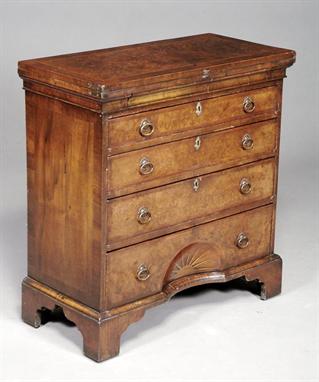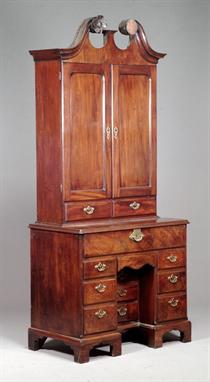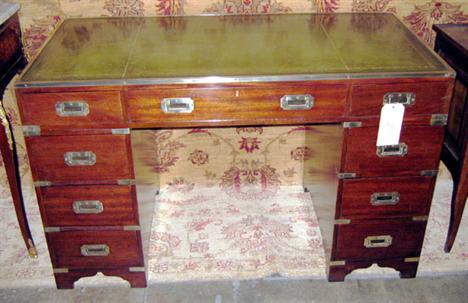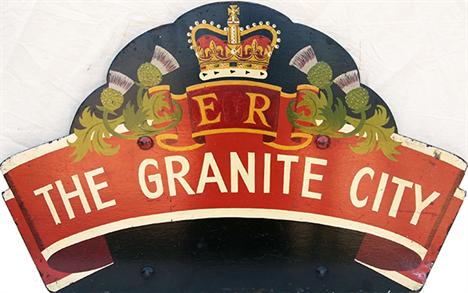We found 177913 price guide item(s) matching your search
There are 177913 lots that match your search criteria. Subscribe now to get instant access to the full price guide service.
Click here to subscribe- List
- Grid
-
177913 item(s)/page
A mahogany eight-day quarter chiming longcase clock, bearing signature for Francis Bennett, Shipston-on-Stour, early 19th century and later, now with triple-train key wound weight-driven movement with anchor escapement and a choice of Whittington, St. Michael and Westminster chimes on eight gongs and striking the hour on a cluster of four further gongs, the 13.25 inch white painted Roman numeral break-arch dial with subsidiary seconds dial and bearing signature FRANCIS BENNETT, SHIPSTON-ON-STOUR to centre, the chapter ring with Arabic five-minute outer track within floral painted spandrels, the arch decorated with a Ho-Ho bird within delicate floral sprays, in a case with blind fret infill to the swan neck pediment and fluted columns to hood above shallow-arch door flanked by fluted quarter columns to trunk, on conforming crossbanded plinth base with moulded skirt incorporating bracket feet, 206cm (7ft 1in) high. condition report:** This clock has 20th century weight driven quarter chiming movement attached to a period dial plate which has been re-finished and signed by the clockmaker who undertook the conversion. Both movement and dial are in fine condition and clock should run and chime once set up correctly. Case is an early 19th century Scottish case and is in sound cosmetically restored condition with the only significant noticeable faults being vertical shrinkage cracks to the plinth base. The clock comes with weights, pendulum, case key and winder IMPORTANT NOTES REGARDING THE CATALOGUING OF CLOCKS Movements, dials and cases Movements and dials are described as relating to the cases in which they are housed in one of the following three ways: the case... we are of the opinion that the movement and dial started life in the current case. in a case... we are of the opinion that the movement and dial are in a case of correct period and type (and may well be original to the movement and dial), however there is evidence to suggest that they may not have started out life together. now in a case... we are of the opinion that the movement and dial are no longer in the original case or one of correct period and/or type. Pendulums, weights, winding and case keys Unless specifically indicated otherwise in the catalogue description it can be assumed that all clocks are sold with the requisite pendulum and correct number of weights (where appropriate), however we cannot guarantee that they are original to the clock. We do not indicate in the catalogue description whether winding or case keys are present with any specific clock. As many are consigned without keys please check with the department to establish whether they are present or not prior to bidding. Condition Due to the mechanical nature of clocks and the fact that most are of great age we cannot offer any guarantee as to whether they are in working order or free from major faults or restoration. Although we endeavour to catalogue items in a fair and informed manner, omission of any comments or observations regarding the condition or originality of a clock in the description does not necessarily indicate that it is free from significant faults, restoration or is in working condition. We would strongly advise any prospective purchaser to view the item in person or request a condition report and/or further images prior to bidding. Measurements Dial measurements are given in inches, other dimensions such as height are given in centimeters (and inches for English clocks). The measurement given for the height of a longcase clock excludes any removable finials in order to provide an approximate minimum ceiling height in which the clock can be accommodated.
A Victorian Scottish mahogany eight-day longcase clock, Farquarson, Dundee, mid 19th century, the four pillar rack and bell striking movement with 13 inch white painted Roman numeral break-arch dial with subsidiary seconds and calendar dials and signed Farquarson, Dundee to centre, the angles with four seasons spandrels beneath ploughing scene to arch, the swan neck pedimented case with shaped-top trunk door flanked by split baton applied uprights, on panel-fronted plinth base with bracket feet, 210cm (6ft 11ins) high excluding eagle finial.
A Regency brass mounted ebonised chamfer top bracket clock, unsigned, circa 1825, the five pillar twin fusee bell striking movement with anchor escapement and 8 inch circular convex silvered brass Roman numeral dial within cast brass bezel, the case with raised chamfer top upstand and fluted frieze to the cavetto moulded cornice above shaped brass fillet inset quadrant panels to front door flanked by brass inlaid canted angles and lions mask ring handles above rectangular fishcale frets to sides, on moulded base with brass ball feet, 41cm (16ins) high.. Provenance: The property of Viscount Portman, Spencer House thence by descent to The Late Henry Clive and Mrs. Clive, formerly of Perrystone Court, Herefordshire. condition report:** Movement appears to be complete and original, it will run and strike but is due for a clean and overhaul. The pendulum is fairly long which has necessitatied a hole to be cut in the bottom of the case and a box applied to the underside to enclose where the bottom of the pendulum bob passes through. This detail appears to have been done a long time ago possibly at the time of manufacture. The movemernt securing brackets are original and there are no signs of this case ever containing a different movement and dial. The convex section of the dial is backed onto a flat circular brass plate which appears to be a piece of salvaged brass as it has a couple of old sporious filled holes and other surface blemishes, the dial itself is discoloured/tarnished but undamaged. There is a possibility that at some point early in the clocks life that the dial was changed from a white painted version to the current engraved silvered brass arrangement (hence the salvaged brass plate). The case is generally in presentable condition, the only noteworthy faults being a fairly crude repair to the strip of veneer lining the top flat section along the back of the case, this could very easily be improved by a good case restorer. as well as some light scuffing next to the bezel where attempts have been made to open the front . Otherwise damage limited to minor bumps scuffs, scatches cracks and small veneer chips commenserate with age and use. Brass fittings appear original and retain original lacquered finish albeit discoloured in places (particularily the feet). Clock comes with case lock key but no winder. IMPORTANT NOTES REGARDING THE CATALOGUING OF CLOCKS Movements, dials and cases Movements and dials are described as relating to the cases in which they are housed in one of the following three ways: the case... we are of the opinion that the movement and dial started life in the current case. in a case... we are of the opinion that the movement and dial are in a case of correct period and type (and may well be original to the movement and dial), however there is evidence to suggest that they may not have started out life together. now in a case... we are of the opinion that the movement and dial are no longer in the original case or one of correct period and/or type. Pendulums, weights, winding and case keys Unless specifically indicated otherwise in the catalogue description it can be assumed that all clocks are sold with the requisite pendulum and correct number of weights (where appropriate), however we cannot guarantee that they are original to the clock. We do not indicate in the catalogue description whether winding or case keys are present with any specific clock. As many are consigned without keys please check with the department to establish whether they are present or not prior to bidding. Condition Due to the mechanical nature of clocks and the fact that most are of great age we cannot offer any guarantee as to whether they are in working order or free from major faults or restoration. Although we endeavour to catalogue items in a fair and informed manner, omission of any comments or observations regarding the condition or originality of a clock in the description does not necessarily indicate that it is free from significant faults, restoration or is in working condition. We would strongly advise any prospective purchaser to view the item in person or request a condition report and/or further images prior to bidding. Measurements Dial measurements are given in inches, other dimensions such as height are given in centimeters (and inches for English clocks). The measurement given for the height of a longcase clock excludes any removable finials in order to provide an approximate minimum ceiling height in which the clock can be accommodated.
A Queen Anne walnut bureau bookcase, circa 1705, of small proportions, crossbanded and featherbanded, with domed top above two mirrored doors opening to an arrangement of shelves and pigeon holes, above two candle slides, the fall opening to an arrangement of dished and serpentine drawers, drawers and pigeon holes above a well, above two short and two long drawers, the lowest drawer incorporating a dished marquetry sunburst, on bracket feet, 196cm high, 77cm wide, 57cm deep
A walnut and featherbanded bachelor’s chest of drawers, in George II style, 20th century, the hinged rectangular folding top above an arrangement of four long graduated drawers, the lower drawer with dished marquetry sunburst, above cushion moulding and bracket feet, 79.5cm high, 76.5cm wide, 36cm deep
A walnut bachelor’s chest of drawers, circa 1740 and later, the quarter veneered, featherbanded and crossbanded top, above a brushing slide, two short and three long crossbanded and featherbanded drawers , on bracket feet, 80cm high, 76cm wide, 48cm deep condition report:** Marks, scratches and abrasions consistent with age and use. Some old closed splits, chips and losses to veneers. Feet are later replacements, variation in colour. Handles not obviously replaced but we cannot guarantee these are original. Locks replaced. Significant replacements to veneers with some additional simulation. Drawer linings are oak, clean and possibly replaced. Some minor evidence of old worm and fragmentary losses. Top slightly warped, small gap between brushling slide and top. Brushing slide and bearers clean, possibly replaced. Restored condition overall with some restorations
A George I mahogany coffer, circa 1720 and later, the hinged top opening to a plain interior, with shaped apron and bracket feet, 40cm high, 62cm wide, 32.5cm deep condition report:** Marks, scratches and abrasions consistent with age and use. Stand and lower moulding later probaly 19th century. Lock, hinges, some sections of replacement to outer edges of top. Lock has age but probably replaced
A George II walnut chest of drawers, circa 1740, the quarter veneered, crossbanded and featherbanded top, above a brushing slide and three short and three long drawers on bracket feet, 82cm high, 77cm wide, 48cm deep condition report:** Marks, scratches and abrasions consistent with age and use Some old closed splits, chips, minor replacements and losses to veneers Horizontal split across the top and some slight warping No evidence to suggest handles or locks replaced Some additional simulated figuring Evidence of old worm and old closed splits particularly to the sides Feet possibly reduced in height, some repairs and later elements to feet
A George III mahogany secretaire bookcase, circa 1780, the moulded cornice above a pair of astragal glazed cabinet doors enclosing adjustable shelves, the fall front secretaire drawer opening to small drawers and pigeon holes, three further long drawers, on bracket feet, 225cm high, 117cm wide, 59cm deep
A George III oak bureau bookcase, circa 1800, the dentil cornice above two doors with patera marquetry, opening to shelves, flanked by fluted columns, the fall opening to an arrangement of drawers, pigeon holes, above two short and two long drawers, on bracket feet, 210cm high, 63cm deep condition report:** Marks, scratches and abrasions consistent with age and use Top and base possibly associated
A George III mahogany and crossbanded serpentine fronted chest of drawers, circa 1770, in the manner of Thomas Chippendale, with a baize lined brushing slide, above four graduated drawers flanked by scrolling ourswept corners with carved acanthus, trailing bellflower and fluting, on bracket feet, 83cm high, 121cm wide, 61cm deep. Bearing retailer’s ivorine plaque for ‘M. Harris & Sons, 44/52 New Oxford Street, London, WC1. This dressing chest of drawers relates to a design for a ‘French Commode Table’ in Thomas Chippendale’s The Gentleman and Cabinet-Maker’s Director, 1754, pl. XLVIII. A further device characteristic of his work is the use of paneled pilasters invariably headed by scrolled brackets above pendent strings of finely carved and detailed husks or bell flowers. Related pilasters are found on documented examples of mahogany case furniture dating from the 1760s, such as the pair of Library Bookcases supplied to Sir Lawrence Dundas for 19 Arlington Street in 1764, and the Library Table and Commode Clothes-Press, both commissioned for Nostell Priory in 1766. The design of handle used for this commode was much used by Chippendale at Nostell Priory, including on a green and gilt japanned clothes-press (C.Gilbert, The Life and Work of Thomas Chippendale, London 1978, vol. II, p146, fig. 263). For a closely related chest of drawers see Masterpieces of English Furniture, The Gerstenfield Collection, Edward Lennox-Boyd, Christie, Manson and Woods Ltd, 1998, page 191, Pl. 2. This chest with similar outswept front corners, by repute from Lyme Park, Cheshire condition report:** Marks, scratches and abrsasions consistent with age and use. Some old closed splits, minor repairs and restorations to feet .Cleaned restored condition overall
A George III mahogany chest of drawers, circa 1780, with two short and three long graduated drawers, on bracket feet, 90cm high, 95cm wide, 52cm deep condition report:** Marks, scratches and abrasions consistent with age and use. Replacements to veneers. Old closed splits. Cleaned, some variation in colour. Locks replaced, escutheons replaced, handles differ so probably later replacement
An Irish George III mahogany kneehole secretaire bookcase, circa 1760, the swan neck pediment with carved flowerhead, above a pair of cupboards opening to shelves, above two short drawers, the base with a secretaire drawer opening to a green leather inset sliding writing surface, above a well and fitted trays and drawers, above an apron drawer and a three short kneehole drawers, flanked on either side by three short drawers on bracket feet, 235cm high, 103cm wide, 58cm deep (formally with an eagle finial, one roundel lacking). Provenance: By descent to the current owner. Previously purchased from Bennett & Stow, Alresford, 9th May 1979 for £5,500 (original receipt available) For a closely related cabinet see Christie’s, King Street, London, 22nd January 2009, Lord St. Helens and Sir William FitzHerbert The Collections of a Diplomat and a Courtier:- ‘This bureau-dressing-table and mirrored cabinet reflects the George II Romano/British fashion promoted by Richard Boyle, 3rd Earl of Burlington and 4th Earl of Corke (d. 1753), who served as George II’s Lord Lieutenant of Ireland. Roman virtue is evoked by a Roman eagle crowning its triumphal-arched and scalloped temple pediment, whose waved volutes bear roses, sacred to Venus as goddess of Love, and these are sculpted in chivalric gothic fashion. Its antique architecture featured in James Gibbs’, Book of Architecture, 1728, and Isaac Ware’s, Designs of Inigo Jones and Others, 1731 (pl. 63).’ See also Irish Furniture, The Knight of Glin and James Peill,Yale University Press, 2007, p. 121, pl.163, for a very similar secretaire cabinet with eagle finial, carved roundels and of identical arrangement (however with mirrored doors), attributed to Christopher Hearn, supplied in 1764 to Lady Cobbe for Newbridge House. condition report:** Marks, scratches and abrasions consisyent with age and use One flowerhead lacking Formally with an central final or eagle Handles possibly replaced Minor repairs and restorations to veneer
A George III mahogany clothes press, circa 1790, dentil cornice above a pair of solid cupboard doors, opening to sliding trays, above an arrangement of five long and two short drawers, on bracket feet, 219cm high, 165cm wide, 62cm deep condition report:** Marks, scratches and abrasions consistent with age and use Some chips and losses to moulding Cleaned condition overall
A Victorian giltwood and composition overmantel mirror, circa 1890, with moulded border, the top centered by trophies, above a beveled mirror plate, 97cm high, 147cm wide; and a George III carved giltwood corner wall bracket, circa 1800, the serpentine fronted top, above swag floral frieze and scrolling acanthus, 35cm high condition report:** Marks, scratches and abrasions consistent with age and use. Mirror- thickly regild. Repairs and restorations, minor chips and losses. Mirror plate and back board replaced. Bracket - Chips and losses, regilding
An oak and mahogany longcase clock, signed - Jones, Newtown, the case with a broken swan-neck pediment, branded and crossbanded, rose frieze with marquetry design of scrolling foliage, and a running stallion, shaped door, bracket feet, arched painted dial, river landscape scenes to the lunette and spandrels, a subsidiary seconds dial and date aperture, eight-day movement, striking on a bell.
Headboard THE GRANITE CITY. A painted scroll showing the train name with the initials EIIR and crown atop with thistles either side. This was the Scottish Region’s “Coronation” headboard and was carried between Glasgow and Aberdeen for a few weeks either side of 2nd June 1953 and then went in to store. Painted wooden board 32” x 20” in good condition. This was acquired by the president of the Scottish branch of the Stephenson locomotive society and the bracket originally on the back has been removed to facilitate display.
-
177913 item(s)/page




















































